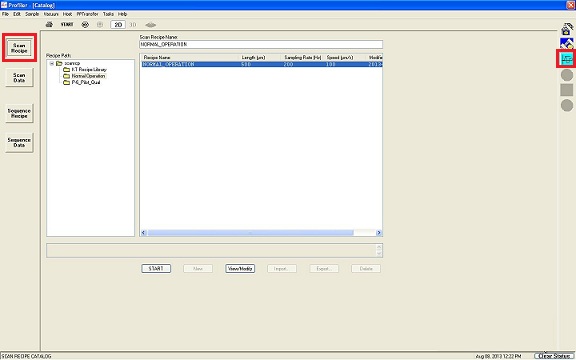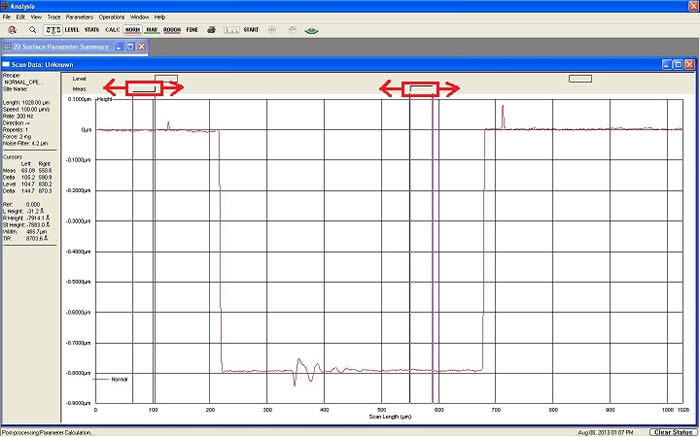
Updated on 12/19/2014
1 The "Catalog" Window
2 Load Sample
3 Scan Surface Profile
3.1 Choose Recipe
3.2 Set Scan Parameters
3.3 View The Surface
3.4 Start Scan
3.5 Level Scan
4 Measure Surface Profile
5 Save Surface Profile
6 Print Surface Profile
7 Unload Sample
1. You will see the "Catalog" window.
2. Click the light-blue "Scan" icon on the right side, and the "Scan Recipe" button on the left side.
1. Open the front door.
2. Ensure that a sample chuck is in a loading position (close to the window).
3. If not, choose and click "Manual Load" from the drop-down menu of "Sample" in the Menu.
4. The sample chuck is moved automatically to the loading position.
5. Load your sample on the sample chuck.
6. Turn on the stage vacuum if necessary.
7. Close the front door.
8. Choose and click "Manual Load" from the drop-down menu of "Sample" in the Menu again.
9. The sample chuck is moved automatically beneath the stylus.
1. Choose "NORMAL OPERATION" from the "Normal Operation" directory.
2. Click the "View/Modify" button.
3. The "Security Information" dialog box appears. Click "OK".
1. The "Recipe Editor" window shows up.
2. Input the parameters, and click the "X/Y view screen" icon.
1. The CCD image window ("Teach Scan Length") appears.
2. Click the "FOCUS" icon.
3. The stylus is moved down automatically to focus the image on the surface.
4. You can use arrows in the screen menu or the key board to move the chuck.
5. You can also rotate the chuck manually, using the bar (coarse adjustment) and knob (fine adjustment) under the chuck.
6. The scan length and location can be changed on the image by the mouse.
1. Start a scan by clicking the "START" button on the "Catalog", "Recipe Editor", or "Teach Scan Length" window.
2. The tip of the stylus is not shown on the CCD image during the scanning.
3. The following window appears when the scanning ends.
1. Click "Level" in the Menu.
2. Move the "Level" blocks to the locations where you want to level.
3. Click "Level" in the Menu again.
4. The leveling is done.
1. Move the "Meas" blocks to measure height and/or width of the profile.

2. The measured results are shown on the left column.
1. Choose and click "Save Data" from the drop-down menu of File in the Menu.
2. The data is saved in the "scandata" directory. You can also save this onto your USB memory.
3. You can call your data from the "Scan Data" screen in the "Catalog" window.
4. The .dat file exported from this program has been known to cause issues when opening up in other programs on your personal computer. The following steps allow you to export the graph and a .txt file to analyze the data, using Apex 2D application.
1. Click
icon in the top menu of the Analysis window.
2. This will open the data as a graph in Apex 2D as shown below. You can analyze your data further in this software. To export as a text, click on the "Save current studiable" icon shown below.
3. Save the file type to a "TXT-Ascii Surfaces". The resulting text file will have a column with distance, and the second column tab delimited with the depth measurements as shown below.
4. You can export the graph by clicking File -> Print a page as an image...
1. Click "File" in the menu on the "Scan Data" screen on the "Catalog" window.
2. Choose the data from the right box.
2. Choose how to print or output the data.
1. Choose and click "Manual Load" from the drop-down menu of "Sample" in the Menu.
2. The sample chuck is moved automatically to the loading position.
3. Take out your sample.
4. Close the front door.